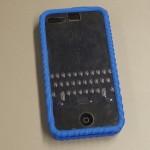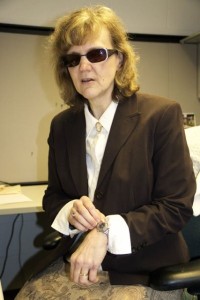Barbara lost her vision when she was 7 years old due to Stevens-Johnson Syndrome (SJS). This syndrome causes damage to the mucous membrane. When she was diagnosed with SJS not much was known about the disease and there was not any therapy and she therefore lost her sight.
Barbara went to the University of Evansville for music therapy. When her kids were young she did some teaching of music & movement for a few different private schools. But, she was always drawn to advocacy work.
Barbara got involved in advocacy with the Bloomington Community Council on Accessibility as an advocate and then moved, in 2000, to Virginia where she took a position as a systems advocate for an Independent Living Center. She spent time researching and advocating for accessible education, housing and transportation. She indicated that transportation became her area of major interest. She has always found accessibility of technology and transportation to be the two most challenging things that she deals with due to her blindness.
 When she started her position as a system’s advocate she had no computer skills. So she jumped into a new position all while learning new technology. She started using JAWS
When she started her position as a system’s advocate she had no computer skills. So she jumped into a new position all while learning new technology. She started using JAWS  software for e-mail reading. She then learned other ways to use the computer with JAWS such as creating documents. She is also a Braille user. She uses a Braille overlay on her iPhone. The Braille overlay helps her with texting and also to respond to email. She indicates she was very hesitant to use an iPhone even though fellow friends with vision problems kept singing the praise of the accessibility of an iPhone. She could not envision how a flat screen would be accessible for her and when she learned of the Braille overlay she gave it a try. She never wants to lose the ability to touch type with her iPhone and always wants to have a little more command of technology and is the reason she uses her Braille layover and not Siri. She now can’t imagine not having her iPhone and indicates that she loves it. The other piece of technology she says she cannot be without is her Braille watch (as shown to the left).
software for e-mail reading. She then learned other ways to use the computer with JAWS such as creating documents. She is also a Braille user. She uses a Braille overlay on her iPhone. The Braille overlay helps her with texting and also to respond to email. She indicates she was very hesitant to use an iPhone even though fellow friends with vision problems kept singing the praise of the accessibility of an iPhone. She could not envision how a flat screen would be accessible for her and when she learned of the Braille overlay she gave it a try. She never wants to lose the ability to touch type with her iPhone and always wants to have a little more command of technology and is the reason she uses her Braille layover and not Siri. She now can’t imagine not having her iPhone and indicates that she loves it. The other piece of technology she says she cannot be without is her Braille watch (as shown to the left).
When she moved back to Bloomington in 2008, she started working for the Area Center for Independent Living. Here she provided 1 on 1 advocacy for clients. She learned that she enjoyed working with systems more than individual advocacy and started looking at Bloomington’s transportation system. She saw some gaps in the accessibility of transportation and in the long-range transportation planning process.
She learned of a grant opportunity that Easter Seals Project Action provided for coalition building and formed a partnership with Bloomington Transit and the Metropolitan Planning Organization (MPO), and the Monroe County Coalition for Access and Mobility (MCCAM) was born from the award of this grant. From this coalition, the vision for the mobility management position was created and a New Freedom grant from the department of transportation was awarded to Bloomington Transit. The grant was contracted out to the area agency on aging and Barbara was hired as the Mobility Manager.
The goal of the New Freedom grant is to expand the transportation options for people with disabilities beyond the ADA requirements for transportation. In the first grant, she developed the New Freedom transportation voucher program, and began researching volunteer driver programs and mobility counseling materials. The New Freedom transportation voucher program allows people with disabilities access to taxi rides at a reduced cost. E2 taxi is one of the participating cab services that will accept the voucher as payment and they have wheelchair accessible vehicles. In addition, Barbara is also researching existing area transportation services for coordination and possible development of additional transportation options.
She is now in her second year of grant-funded project and this grant is through INDOT. This grant is focusing on mobility education, travel training, and mobility counseling. She is out in the community speaking to people about planning ahead for their transportation needs as they get older. She asks people to think about their transportation needs and encourages them to find ways to keep transportation planning in the forefront so they can maintain their independence.
She is also thinking about creative ways to get people from Bloomington to Indianapolis for doctor appointments. She indicates, “We don’t live in closed communities. We are a regional society and people may have doctors outside of their immediate area”.
Barbara became a consumer of Vocational Rehabilitation when she was doing this grant work and was looking to upgrade her JAWS software and receive training. She was referred to Easter Seals Crossroads Assistive Technology department and was assigned to work with Belva Smith. She wanted to work with someone who was dependable and would listen to her. She researched the available providers and determined Belva was the right person for the job. Belva helped her install updated software and provided her with more advance JAWS training and also taught her how to use the software with social media. Barbara said she enjoys working with Belva because “she works with the kind of learner I am and teaches me how to use what I want to use”. She indicated that Belva said, “What do you need to know?” and then taught her “the way she liked it”.
With assistive technology tools such as a computer and JAWS software, along with the support and training of an assistive technology specialist, Barbara is enabled to be a wonderful voice and advocate for all people with vision and other disabilities who struggle with transportation issues in the Bloomington area. She is a great example of how assistive technology can enable someone to work independently and be such a positive contribution to society.


